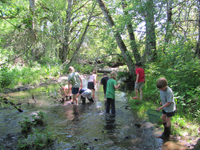
It’s a warm spring morning as sixth-grade students from Eddyville Charter School tromp through the forest to get to their field site. For most of them, this is their fist visit as scientists, but they have been studying data from the site in class and will return three times a week throughout the unit. Sean Bedell—their teacher—is using the Oregon Sea Grant (OSG) StreamWebs program to meaningfully engage his students in citizen science.
“I show them all of these different sample methods like transects and temperature, and the kids come up with their own research questions,” Bedell said.
StreamWebs is just one of many active citizen science programs throughout Oregon. The project involves middle and high school students adopting a field site and collecting data on things like water quality or invasive species. The larger goal is to expose students to science in a fun way that still has relevance.
“Using StreamWebs allows you take your typical field trip and make it more of a lab,” said Megan Kleibacker, an OSG employee who helps lead StreamWebs. “There are different things you need to do to hit on Next Generation Science Standards, and StreamWebs allows for that.”
In 2010, Kleibacker helped integrate StreamWebs into OSG after it lost the support of its prior sponsor. The switch required her to identify new sources of funding since StreamWebs is entirely supported by grants. She says that sponsors were excited by the scientific rigor of a program that still offered a fun experience for students.
“StreamWebs offered something that other programs didn’t, and that was a connection between real, meaningful field work for students and classroom work,” Kleibacker explained.
StreamWebs also hosts a detailed website where classes and individual students can post their data. The searchable database provides a way for students to compare their data against previous years, and graph changes over time.
To date, over 400 students have utilized the StreamWebs program to connect with science. Kleibacker hopes to start tracking program alumni in the future to see where students end up after becoming scientists at a young age.